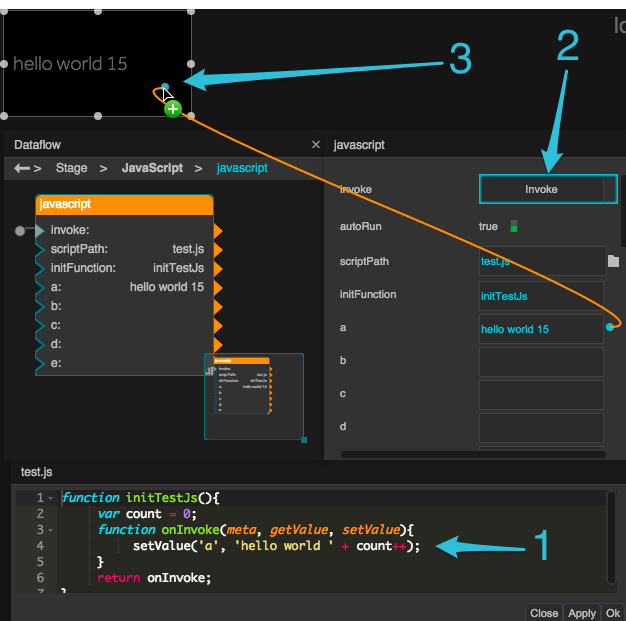Table of Contents
JavaScript
| Block Group: | Browser API |
| Block Icon: |  |
Enables loading and running JavaScript and accessing JavaScript and HTML APIs.
This block is similar to the Script block, but it has two main differences:
- The JavaScript block uses regular JavaScript, which allows it to access JavaScript and HTML APIs directly. The JavaScript block uses
metato interact with the JavaScript of the page.metacan have two properties,elementandgmap, both of which apply to the JavaScript block's parent object. In contrast, the Script block uses DGLux script, including DGLux5 page model syntax such as@parent. Because of this, the JavaScript block is a better choice for accessing APIs and the Script block is a better choice for accessing the DGLux5 page model in script. - To access the code, the JavaScript block takes a path to a JavaScript file in the project, and the Script block takes script input as a multi-line text property.
The JavaScript is loaded in the global namespace of the page and must meet the following requirements:
- It must include a special
initfunction, because theinitfunction creates an instance of the script that is differentiated from any other instances that might be running on the page. - The special
initfunction must return a function to be executed when the block is invoked. - The function returned by the
initfunction must takemeta,getValue, andsetValueas parameters.
If you make changes to the JavaScript code, these changes will take effect only if you refresh the browser—not simply if you close and reopen the .dg5 file.
In the example:
initTestJsis the specialinitfunction.- The
onInvokefunction is returned by theinitfunction and is executed when the block is invoked. - The function to be executed takes
meta,getValue, andsetValueas parameters.
You can use getValue and setValue to interact with the custom parameters of the block. These custom parameters appear as properties that you can bind to other properties in DGLux5. The syntax to use setValue is setValue('a', newValue). This sets the value of the DGLux5 property a to newValue. The syntax to use getValue is getValue('a'). This returns the current value of the DGLux5 property a.
Input/Output Properties
These properties can take input and give output.
- invoke (trigger)
- autoRun (boolean)
- scriptPath (string)
- initFunction (string)
- custom parameters
invoke causes the JavaScript to be loaded in the global source for the page and runs the init function.
autoRun specifies whether the script runs automatically.
- TRUE: The script runs every time the script is changed, and every time any property is changed. This includes the first time that the script is initialized.
- FALSE: The script runs only when the invoke property is triggered.
scriptPath specifies the path to the JavaScript file. It can be a DGLux5 file path relative to the root, or it can be some other URL. The file extension must be .js.
initFunction specifies the name of the init function in the file.
The custom parameters set or return the values of properties that you can use in your script as needed.
Remarks
- You can add a blank
.jsfile to your project, and then click Edit in Window in the Details panel to edit the file within DGLux5.
Edit in Window in the Details panel to edit the file within DGLux5. - To test your JavaScript, you must save the DG5 file and reload DGLux5—don't merely close and open the
.dg5file. Changes to JavaScript take effect only when the page is reloaded. - If you use the Script block to access Google Maps API, the map’s initialization time can cause
meta.gmapto benull. To ensure that this issue is avoided, bind the onMapInit event in the map widget's Advanced properties to the invoke property of the JavaScript block. - To create a custom parameter, click the plus sign in the block.
- To delete a custom parameter, right-click it in the block property inspector (the right-hand panel of the dataflow window), and select Remove Parameter.
- Bind an event to invoke, and bind the custom parameters to other properties in DGLux5.
Model
This is a basic use of the block.
Sample Code
The example on this page uses the following code:
function initTestJs(){
var count = 0;
function onInvoke(meta, getValue, setValue){
setValue('a', 'hello world ' + count++);
}
return onInvoke;
}
Google Maps API Example
Use this code in the dataflow of a Google Map component to add a marker in Australia on the Google Map component. For initFunction, use initMapForDGLux.
function initMap(map) {
var myLatLng = new google.maps.LatLng(-25.363, 131.044);
var marker = new google.maps.Marker({
position: myLatLng,
map: map,
title: 'Hello World!'
});
}
function initMapForDGLux() {
function runScript(meta, getValue, setValue) {
if (meta.gmap != null) {
initMap(meta.gmap);
}
}
return runScript;
}
More Resources
These videos show the JavaScript block in use:
